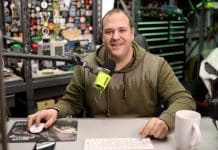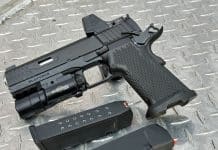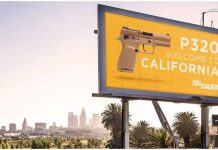Bail enforcement agents often face dangerous situations in the performance of their work; there is no doubt that the greatest risk comes from concealed weapons and firearms in the possession of those who would do us harm. The reality of our work is that there are evil people out there who will kill us if given the opportunity and situational awareness is the greatest tool investigator may employ to identify danger before it is too late. Visual weapons screening is an easily learned and valuable skill that helps bail agents during an apprehension (or others with security concerns) spot individuals who deserve closer attention and, when appropriate and lawful, a physical search.
The U.S. Secret Service, backed up by three studies over a period of 15 years and published in the FBI Law Enforcement Bulletin (3/06), indentified the following visual cues indicating a person may be carrying a concealed weapon:
Behavioral Traits
In all three aforementioned studies, none of the criminal offenders interviewed used a holster and male offenders reported regularly carrying handguns in the middle torso area; more specifically they tended to tuck the firearm into their right front waistband, between their navel and hip, in order maintain the gun’s accessibility. One researcher noted that, “They see guns put there in the movies, it’s ‘cool,’ and they can easily show their buddies or enemies that they’re armed.” One city law enforcement agency conducting their own study noted that of the 1,301 guns confiscated from suspects, only seven of them were wearing holsters. The second most common hiding place is the small of the back – but it is a distant second place.
Concealed firearms tend to be carried on the person’s “strong side,” which is to say on the same side as their dominant hand. Is the subject left-handed or right-handed? Typically, wristwatches are worn on the weak arm and, generally, people use their strong hand for most actions like lighting cigarettes, shoving someone, holding or moving objects, etc. Even in the absence of confirming visual clues, you can count on approximately 85% of the people in the world being right handed. Knowing a person’s strong side gives the observer a better chance of locating a hidden gun quickly.
Walking with a concealed, unholstered handgun requires subjects to occasionally touch their firearms to prevent the gun from moving or to adjust the weapon after it moves. This movement is often referred to by law enforcement instructors as the “security feel” and becomes most notable whenever individuals change body positions, such as standing, sitting, or exiting a car because the unholstered gun tends to shift, causing the subject to adjust or reposition the weapon to the preferred position. When a subject runs, their actions may appear more pronounced; constantly gripping the handgun to maintain control.
An academy instructor for the U.S. Secret Service uniformed division recently shared the following tip online, “Closely related to the security feel is what I call ‘protective body movement.’ This is particularly noticeable when an armed subject is running or moving abruptly; he holds his arm against the concealed weapon, either stiffly or with a very restrained swing. Even if the suspect is just walking, you may see that he takes a full stride with his opposite-side foot but the gun-side stride will be shorter, almost like a limp in some cases because he’s trying to clamp the gun in place and minimize its slipping or its risk of falling out. The arm may also come in against the gun as a protective movement when people start getting close to the suspect.”
“Watch females who are with bikers and other street gangs,” one police officer cautioned, “many times they carry for the male members, capitalizing on the fact that too many people tend to dismiss females as a threat.”
The studies also concluded that “the majority of female offenders who carried their own weapon preferred small-framed revolvers or automatic pistols. Their preferred place of concealment was in a pocket of their outer clothing, with quick retrieval as their primary concern. Females often carried a weapon for a male companion prior to or after criminal activity. But, interestingly, no female offender reported giving her weapon to anyone to carry for her.”
Basic law enforcement training teaches officers to keep their gun-side away from individuals during street contacts or interviews. It is widely accepted that armed criminals do the same in encounters with law enforcement professionals to ensure concealment and easy access to their firearms. As one offender in the study noted, “If they’re on that side of me, they can’t see it. I can also get to it quicker if I need to. Because they can’t see what I’m reaching for, I get that extra second.”
Additional physical behaviors may include “palming,” which is most often observed in subjects concealing edged weapons but occasionally seen with gun wielders, too. The knife holder may run the blade of the weapon up along the arm or behind the leg to conceal it from frontal view. Just before a target is attacked, an attacker will also typically have his or her eyes fixed on the intended victim. Palming behaviors often indicate imminent risk to the recovery agent!
I remember one situation in particular when I found a gun in the coat pocket of a fugitive I was chasing through a house that I distinctly heard the sound of the gun hitting a door frame and then coming to rest on a countertop when I had him leaned forward and placing him in handcuffs. It was obvious by the heavy, solid thud that there was a large metal object in his pocket.
Clothing Indicators
The most obvious giveaway is the telltale bulges in a subject’s clothing. A gun is not flexible and doesn’t conform well to the shape of the human body, so it may reveal itself in the form of a protrusion. While the entire firearm may not be outlined, tight clothing may reveal bumps that relate to a hammer, grip or muzzle. This distortion of the subject’s silhouette is often referred to as “patterning” or “imprinting.” When trying to conceal a shotgun, rifle or submachine gun under a coat while walking, the butt of the weapon will often cause a noticeable bulge behind the armpit. Additionally, the jacket does not move naturally because it is supported by the outline of the weapon. When someone wears a shoulder holster or straps on a sawed-off rifle, shotgun or submachine gun under his or her arm, a bulge in front of or behind the armpit will often be visible.
Specific observations regarding a person’s attire may indicate that the individual is armed. These may include, but are not limited to, what individuals are wearing during various weather conditions, as well as accessory items and unconventional weapons designed and manufactured for concealment that they may carry. Clothing concealment techniques are used by people to hide firearms and other weapon; for example, an un-tucked shirt or buttoned sports jacket are two examples of techniques used to conceal dangerous objects with clothing. These characteristics may not always be obvious though as casual dress with un-tucked shirts is quite common. Even though an un-tucked shirt may hide a firearm, in and of itself, it is not a good indicator. An investigator must judge the concealment characteristics in the context of the environment they are in. With clothing, visual screener need only simply ask, “Does what I see match the surroundings?”
Warm Weather Conditions
Is the individual dressed inappropriately for existing weather and temperature conditions? A person who attempts to conceal a weapon may wear or carry additional clothing other than that which is required or appropriate considering the outside temperature and humidity. This suspicious behavior is particularly observable in warm weather. Why would an individual wear a jacket, sweatshirt, sweater, raincoat, or overcoat on a bright sunny day when others are dressed in short-sleeved shirts? Is the individual wearing multilayered clothing, such as two shirts or a pair of sweatpants over a pair of jeans, on a hot day? Similarly, why does a man wearing a shirt and tie, suit pants, and dress shoes have his shirttail hanging out? Less obvious are individuals in casual attire with their shirttails outside their pants. Such inappropriate apparel can cover areas of the body where criminals frequently conceal firearms.
Obviously, it is easier visually detect firearms on individuals dressed appropriately for warm weather. At-risk individuals should look for unnatural protrusions or bulges in the waist, back, and crotch areas and watch for less conspicuous cues, such as shirts that appear rippled or wavy on one side of the body while the fabric on the other side appears smooth. Many offenders in the three studies revealed that they purposely transported weapons in their crotch areas as much for concealment as the reluctance of officers to thoroughly search this location.
Cold and Inclement Weather Conditions
Are individuals with a coat, raincoat, or jacket draped over their arms unnecessarily exposing themselves to the elements? What about those wearing a hooded jacket or coat in the rain or snow without the hood covering the head? One offender stated that he had several friends who carried firearms in their jacket hoods. Does a loose-hanging hood seem weighted down, causing the drawstring to pucker? Also, in periods of extremely cold weather, why would people not button or zip up their jackets or heavy coats? Could it be that they want quick access to a firearm?
When individuals have on jackets and coats, are these pieces of clothing visibly weighted to one side, giving the appearance of an unusually heavy object in the pocket? Normally, personal items such as wallets, keys, and cell phones do not weigh enough to cause a pocket to hang substantially lower than the one on the opposite side– but large caliber guns favored by street thugs typically do. When the subject walks or runs, does his coat or jacket bounce off his leg as if something heavy is in the pocket?
Accessories and Other Items Carried
In cold weather conditions, individuals may have a hand warmer attached to their clothing or person in some manner. If these people appear to have been outside for some time, why are their hands not inside the device? If they have gloves on, why do they need the hand warmer? Does it exhibit ripples or waves in the fabric, giving the appearance of containing a heavy object?
What about individuals carrying such items as purses, knapsacks, fanny packs, soft briefcases, gym bags, folded-over newspapers, or paper bags that appear out of place? Do these articles display a protrusion? Is the outline of the frame of a handgun or a partial contour, such as the barrel or butt, visible? If a subject seems to have a wallet in his pocket but is wearing a fanny pack, then what’s in the fanny pack? Does it appear weighted with a heavy object? Most types of fanny packs can conceal a handgun and many are purposes-built with a draw string or other quick-release closure method added for rapid access to a handgun.
One of the most important concepts of visual weapons screening is behavior clusters; the totality of circumstances will dictate the degree of likelihood of an individual being armed. When evaluating any individual for the possibility of a concealed firearm it is important to take into account their behavior “in context” as well! Wearing inappropriate clothing could be completely explainable, depending on the circumstances and surroundings. For example, a traveler who just arrived from a colder climate may have on an overcoat on a warm sunny day. Perhaps, the person has to carry luggage, making it necessary to temporarily wear the coat. This individual may be near an airport, train terminal, bus station, or subway or in the process of hailing a taxicab. Under these circumstances, the observation of inappropriate clothing for existing weather conditions probably would not constitute a clear indicator that the person may be concealing a firearm because such behavior could be completely understandable. Alert investigators, however, may use these indicators as a reason to take a second, closer look and notice a slight bulge or protrusion or other physical behavior trait that confirms their suspicions.
Unconventional Firearms and Disguised Weapons
Fugitive recovery agents need to remain vigilant for a separate class of firearms designed for concealment. Generally constructed without sights, these weapons, referred to as “belly guns,” usually are inaccurate unless fired at a very close range. Manufacturers also have produced handguns and other weapons intentionally disguised as other objects, including pens, pagers, cell phones, belt buckles, and wallets. Thugs have related that they possessed such weapons to use against anyone who may overlook them during arrest or transport situations. The use of a hand-held magnetometer can assist in detecting these types of handguns and other potentially dangerous metal instruments, such as knives and razors.
Click here for a disguised weapons manual circulated among law enforcement professionals.
Click here for a second guide to additional unconventional hidden and concealed weapons.
Click here for real guns disguised as toys.
Studies indicate that there is no reliable profile of the people who carry and use weapons unlawfully; they are white, Latino, Asian every other race and ethnicity. They are male or female. They wear expensive clothing, including tailored suits, and they are from all socioeconomic classes. It is paramount that all subjects under your control, including those of the opposite sex, be searched for concealed weapons using optimum frisking and location techniques. Recovery agents must remain vigilant and constantly remind themselves that a recovery of a weapon from a suspect should never prohibit the continued search of the subject for additional weapons.
Use these tell-tales as a way to make you conscious of your own actions while wearing a concealed weapon as well. Many investigators who I know carry concealed firearms tend to share many of the same habits, behavior traits and modes of dress discussed in this article. To a knowing individual, you may unconsciously telegraph your armed status in situations where it is best that the presence of a weapon remain concealed such as in an undercover workplace investigation or while conducting field interviews under some pretext.
Knowledge, awareness, clear thinking, and finely honed skills of observation may give investigators an advantage when confronting bail fugitives or their accomplices who may display the specific and unique signals indicating the presence of a firearm or other concealed weapon. However, the absence of such traits and characteristics should never mean that a bail agent should let his or her guard down while in the presence of the fugitive and his or her associates. At the end of the day, we all want to go home safely.
Be careful out there.













I suggest adding a “google+” button for the blog!
Hellen
Thanks Hellen. We’ll look into that!
Consider it done!
Comments are closed.